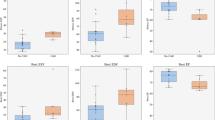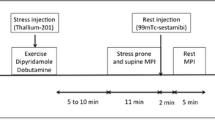Abstract
Introduction
The precise clinical utility of lung 201Tl uptake in exercise SPECT myocardial perfusion imaging remains open to research. This study validates an optimal index for lung 201Tl uptake measurement and assesses its value in the prediction of higher-risk coronary artery disease (CAD).
Method
Three hundred and ninety-eight patients underwent exercise SPECT myocardial perfusion imaging. They were separated into derivation (n = 217) and validation (n = 186) groups, both including sub-populations of lower- and higher-risk CAD, according to coronary angiography. Another 56 individuals with a low probability of CAD comprised the control group. From a planar, anterior, post-exercise acquisition, the lung (L) to heart (H) maximal (L/Hmax), total (L/Hmean) and background-subtracted total (L/Hnet) ratios were calculated. These were also adjusted for confounding variables, as assessed from the control group. ROC analysis was used to compare the L/H ratios and define thresholds of abnormality. The performance of the optimal index was assessed in the derivation group and was then tested in the validation population. Subsequently, it was compared with other scintigraphic, exercise electrocardiography and clinical variables.
Results
In the derivation group L/Hnet was a better discriminator for higher-risk CAD than both L/Hmax and L/Hmean. Similarly, the adjusted L/Hnet was a better discriminator than both the adjusted L/Hmax and the adjusted L/Hmean. No significant difference was attained between L/Hnet and the adjusted L/Hnet. At the upper defined threshold of abnormality, sensitivity and specificity of L/Hnet in the detection of higher-risk CAD in the derivation and the validation cohorts were 52% and 92% versus 47% and 94%, respectively (p = ns). The results were similar at other defined thresholds. Moreover, L/Hnet was found to be a significant predictor of higher-risk CAD, superior to myocardial perfusion images, transient ventricular dilation measurements, and clinical and exercise testing variables (ROC analysis and logistic regression). By raising the threshold of abnormality of L/Hnet, specificity and positive predictive value increased, whereas sensitivity and negative predictive value decreased.
Conclusion
Lung 201Tl assessment assists substantially in the identification of higher-risk CAD in exercise SPECT myocardial perfusion imaging and this is best achieved by L/Hnet. This index is a significant predictor of higher-risk CAD, superior to myocardial perfusion images, and its value is associated with the probability of a disease state.




Similar content being viewed by others
References
Underwood SR, Anagnostopoulos C, Cerqueira M, Ell PJ, Flint EJ, Harbinson M, et al. Myocardial perfusion scintigraphy: the evidence. Eur J Nucl Med Mol Imaging 2004;31:261–91.
Kwok JMF, Christian TF, Miller TD, Hodge DO, Gibbons RJ. Identification of severe coronary artery disease in patients with a single abnormal coronary territory on exercise thallium-201 imaging. J Am Coll Cardiol 2000;35:335–44.
Christian TF, Miller TD, Bailey KR, Gibbons RJ. Noninvasive identification of severe coronary artery disease using exercise tomographic thallium-201 imaging. Am J Cardiol 1992;70:14–20.
Iskandrian AS, Heo J, Lemlek J, Ogilby JD. Identification of high-risk patients with left main and three-vessel coronary artery disease using stepwise discrimination analysis of clinical, exercise and tomographic thallium data. Am Heart J 1993;123:221–5.
Alderman EL, Bourassa MG, Cohen LS, Davis KB, Kaiser GG, Killip T, et al. Ten-year follow-up of survival and myocardial infarction in the randomized Coronary Artery Surgery Study. Circulation 1990;82:1629–46.
Emond M, Mock MB, Davis KB, Fisher LD, Holmes DR Jr, Chaitman BR, et al. Long-term survival of medically treated patients in the Coronary Artery Surgery Study (CASS) registry. Circulation 1994;90:2645–57.
Yusuf S, Zucker D, Peduzzi P, Fisher LD, Takaro T, Kennedy JW, et al. Effect of coronary artery bypass graft surgery on survival: overview of 10 year results from randomized trials by the Coronary Artery Bypass Graft Surgery Trialists collaboration. Lancet 1994;344:563–70.
Boucher CA, Zir LM, Beller GA, Okada RD, McKusick KA, Strauss W, et al. Increased lung uptake of thallium during exercise myocardial imaging: clinical, hemodynamic and angiographic implications in patients with coronary artery disease. Am J Cardiol 1980;46:189–96.
Bingham JB, McKusick KA, Strauss HW, Boucher CA, Pohost GM. Influence of coronary artery disease on pulmonary uptake of thallium-201. Am J Cardiol 1980;46:821–6.
Homma S, Kaul S, Boucher CA. Correlates of lung/heart ratio of thallium-201 in coronary artery disease. J Nucl Med 1987;28:1531–5.
Gill JB, Ruddy TD, Newell JB, Finkelstein DM, Strauss HW, Boucher CA. Prognostic importance of thallium uptake by the lungs during exercise in coronary artery disease. N Engl J Med 1987;317:1485–9.
Kahn JK, Carry MM, McGhie I, Pippin JJ, Akers MS, Corbett JR. Quantification of post exercise lung thallium-201 uptake during single photon emission computed tomography. J Nucl Med 1989;30:288–94.
Morel O, Pezard P, Furber A, Le Jeune LL, Vielle B, Jallet P. Thallium-201 right lung/heart ratio during exercise in patients with coronary artery disease: relation to thallium-201 myocardial single photon emission tomography, rest and exercise left ventricular function and coronary angiography. Eur J Nucl Med 1999;26:640–6.
Chae SC, Heo J, Iskandrian AS, Wasserleben V, Cave V. Identification of extensive coronary artery disease in women by exercise single-photon emission computed tomographic (SPECT) thallium imaging. J Am Coll Cardiol 1993;21:1305–11.
Aksut SV, Mallavarapu C, Russell J, Jaekyeong H, Iskandrian AS. Implications of increased lung thallium uptake during exercise single photon emission computed tomography imaging. Am Heart J 1995;130:367–73.
Diamond GA, Forrester JS. Analysis of probability as an aid in the clinical diagnosis of coronary-artery disease. N Engl J Med 1979;300:1350–8.
Martin W, Tweddel AC, Main G, Hutton I. A comparison of maximal exercise and dipyridamole thallium-201 planar gated scintigraphy. Eur J Nucl Med 1992;19:258–64.
Moralidis E, Spyridonidis T, Arsos G, Apostolopoulos D, Karatzas N, Vassilakos P, et al. 201Tl gated single-photon emission computed tomographic myocardial perfusion imaging in the assessment of global and regional left ventricular function. Would it be favoured over equilibrium radionuclide angiography? Nucl Med Commun 2004;25:665–73.
Hachamovitch R, Berman DS, Shaw LJ, Kiat H, Cohen I, Cabico JA, et al. Incremental prognostic value of myocardial perfusion single photon emission computed tomography for the prediction of cardiac death: differential stratification for risk of cardiac death and myocardial infarction. Circulation 1998;97:535–43.
Mazzanti M, Germano G, Kiat H, Kavanagh PB, Alexanderson E, Friedman JD, et al. Identification of severe and extensive coronary artery disease by automatic measurement of transient ischemic dilation of the left ventricle in dual isotope myocardial perfusion SPECT. J Am Coll Cardiol 1996;27:1612–20.
ACC/AHA 2004 guideline update for coronary artery bypass graft surgery. A report of the American College of Cardiology/American Heart Association task force on practice guidelines. http://www.acc.org.
Hanley JA, McNeil BJ. A method of comparing the areas under receiver operating characteristic curves derived from the same cases. Radiology 1983;148:839–43.
Levy R, Rozanski A, Berman DS, Garcia E, Van Train K, Maddahi J, et al. Analysis of the degree of pulmonary thallium washout after exercise in patients with coronary artery disease. J Am Coll Cardiol 1983;2:719–28.
Rozanski A, Diamond GA, Forrester JS, Berman DS, Morris D, Swan HJC. Alternative referent standards for cardiac normality. Ann Intern Med 1984;101:164–71.
Shaw LJ, Peterson ED, Shaw LK, Kesler KL, DeLong ER, Harrell FE, et al. Use of a prognostic treadmill score in identifying diagnostic coronary disease subgroups. Circulation 1998;98:1622–30.
Arsos G, Moralidis E, Karatzas N, Iakovou I, Georga S, Koliouskas D, et al. Heart rate is the major determinant of diastolic filling pattern during growth: a radionuclide ventriculography assessment. Pediatr Cardiol 2002;23:378–87.
Kushner FG, Okada RD, Kirshenaum HD, Boucher CA, Strauss HW, Pohost GM. Lung thallium-201 uptake after stress testing in patients with coronary artery disease. Circulation 1981;63:341–7.
Kurata C, Tawarahara K, Taguchi T, Sakata K, Yamazaki N, Naitoh Y. Lung thallium-201 uptake during exercise emission computed tomography. J Nucl Med 1991;32:417–23.
Daou D, Delahaye N, Lebtahi R, Vilain D, Peker C, Faraggi M, et al. Diagnosis of extensive coronary artery disease: intrinsic value of increased lung 201Tl uptake with exercise SPECT. J Nucl Med 2000;41:567–74.
Tweddel AC, Martin W, McGhie I, Hutton I. Improved detection of coronary artery disease by estimated myocardial thallium uptake. Eur J Nucl Med 1989;15:336–40.
Martin W, Tweddel AC, Hutton I. Balanced triple-vessel disease: enhanced detection by estimated myocardial thallium uptake. Nucl Med Commun 1992;13:149–53.
Mannting F. A new method for quantification of pulmonary thallium uptake in myocardial SPECT studies. Eur J Nucl Med 1990;16:213–22.
Ilmer B, Reijs AEM, Fioretti P, Reiber JHC. Comparative study of three different approaches on the estimation of the lung-heart ratio in thallium-201 scintigrams in relation to the extent of coronary artery disease and left ventricular function. Eur J Nucl Med 1992;18:252–8.
Rothendler JA, Boucher CA, Strauss HW, Pohost GM, Okada RD. Decrease in the ability to detect elevated lung thallium due to delay in commencing imaging after exercise. Am Heart J 1985;110;830–5.
Sanderson R, Woldman G, McCurrach G, Martin W, Hutton I. Lung uptake of thallium-201: a marker of defect reversibility? Phys Med Biol 1998;43:1469–79.
Hitzel A, Manrique A, Cribier A, Vera P. Diagnostic value of Tl-201 lung uptake is dependent on measurement method. J Nucl Cardiol 2001;8:332–8.
Daou D, Delahaye N, Vilain D, Lebtahi R, Faraggi M, Le Guludec D. Identification of extensive coronary artery disease: incremental value of exercise Tl-201 SPECT to clinical and stress test variables. J Nucl Cardiol 2002;9:161–8.
Heller LI, Cates C, Popma J, Deckelbaum LI, Joye JD, Dahlberg ST, et al. Intracoronary Doppler assessment of moderate coronary artery disease. Comparison with 201Tl imaging and coronary angiography. Circulation 1997;96:484–90.
Author information
Authors and Affiliations
Corresponding author
Rights and permissions
About this article
Cite this article
Moralidis, E., Spyridonidis, T., Arsos, G. et al. Identification of advanced coronary artery disease with exercise myocardial perfusion imaging: the clinical value of a novel approach for assessing lung thallium-201 uptake. Eur J Nucl Med Mol Imaging 34, 573–583 (2007). https://doi.org/10.1007/s00259-006-0255-7
Received:
Accepted:
Published:
Issue Date:
DOI: https://doi.org/10.1007/s00259-006-0255-7




